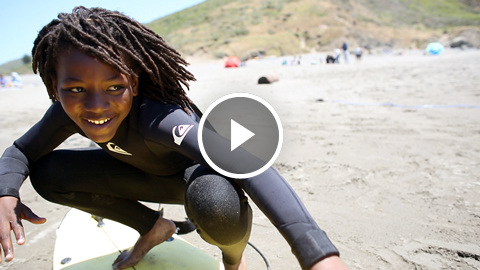One of the great injustices of growing up in an impoverished, gang-ridden neighborhood is that children are deprived of their youths. Murder, hunger, lost parents … such hardships have a way of hardening children into adults long before their time. So it goes in Sunnydale, at the southern edge of San Francisco.
As we learn in this film, Ripple Effect is an organization that takes kids from places like Sunnydale and transports them to the parallel universe of a surfboard, where they can ride on waves and experience pure joy and the beauty of the ocean. Adam Warmington, our director of post production and (in his free time) avid surfer and co-founder of Ripple Effect, is also the one who took the lead distributing this short film once it was finished.
He leveraged his many contacts in the surfing community and his passion for the project to place the film in blogs around the Internet, including the two biggest surf blogs: surfline.com and theinertia.com. He also captured the attention of many top newspapers, both print and online. The San Francisco Chronicle has already run a piece about the film. Stories from GOOD, Surfer Magazine, and The Guardian are forthcoming.
Here Adam shares six tips for social and environmental innovators who would like to find similar traction:
1) Know your audience
I reached out to surfing blogs, as well as local and national news organizations. In this day and age, there’s a blog for every issue, topic, sport, political persuasion, etc. You have to know which blogs specifically cater to your subject matter. Although they tend to be the feeders for the larger media outlets now a days, it doesn’t hurt to reach the traditional media directly with a relevant pitch.
2) Hunt for contacts
I looked for and found the contacts for many different media channels (I spent hours and hours doing this). For blogs, I suggest you contact someone within the given field or use an internal specialist. Given my years of surfing and involvement with the surf community, I already had some of these relationships and contacts.
For news, I approached reporters who looked like they might be interested based upon the type of stories they had previously written. One big innovation was searching say ‘surfing’ within the Guardian site; then I figured anyone who had previously written an article about surfing may be interested to do so again.
3) It’s all about percentages
Email 100 people and a 5 percent return rate will deliver 5 embeds. 1000 people, 50. And so on. The more time you put into reaching out, the more hits you’ll get. It’s basic math.
Once you’ve got the ball rolling, other members of the media whom you haven’t personally contacted will start to see articles and blog posts about your subject matter, and they too will choose to write about it. Much of the inspiration for content in any publication comes from other publications. What you have to do is provide the initial spark, over and over until the fire takes flame.
4) Share your best work
I have worked on a lot of videos. This one was special and the one to blast out.
5) Social media:
Instagram, Facebook, LinkedIn, etc etc — tag people, spread the word, all day every day.
6) It’s about passion
If you make something that you are truly passionate about … all the above doesn’t feel like work.

